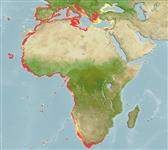Common names from other countries
sub class Elasmobranchii (ฉลามและกระเบน) (sharks and rays) >
Rajiformes (Skates and rays) >
Rajidae (Skates)
Etymology: Raja: Latin, raja, -ae = a sting ray (Raja sp.) (Ref. 45335).
More on author: Linnaeus.
Environment: milieu / climate zone / depth range / distribution range
นิเวศวิทยา
เกี่ยวกับทะเล,น้ำเค็ม; กร่อย สัตว์น้ำหน้าดิน; ระดับความลึก 17 - 462 m (Ref. 56504), usually 50 - 150 m (Ref. 27121). Subtropical; 44°N - 35°S
Northeast Atlantic: from Spain (Bay of Biscay) to Morocco and Madiera, including the Mediterranean Sea.
Length at first maturity / ขนาด / น้ำหนัก / Age
Maturity: Lm ?, range 44 - ? cm
Max length : 63.0 cm TL เพศผู้/กระเทย; (Ref. 39256); 59.7 cm TL (female); common length : 35.0 cm TL เพศผู้/กระเทย; (Ref. 2683)
Short description
เครื่องมือที่ใช้ในการแยกชนิดสัตว์,สิ่งมีชีวิตออกจากกัน | สัณฐานวิทยา | ความยาวต่างๆ
เงี่ยงครีบหลัง (รวม) : 0; เงี่ยงครีบก้น: 0. Snout short and bluntly pointed; disc angular (Ref. 5578). Upper surface prickly only in young, nearly smooth in adults, underside smooth (Ref. 3167). Upper surface ochre to reddish-brown with scattered dark spots, underside white (Ref. 3167); two bright blue eyespots centered on the pectoral bases (Ref. 5578); may have a small dark spot on tip of snout (Ref. 2708).
Found over soft bottoms of the shelf and the uppermost slope (Ref. 5578). Depth range from 17-300 m, and up to depth of 462 m in the eastern Ionian Sea (Ref. 56504). Feed on all kinds of benthic animals, also on fish offal (Ref. 5578). Oviparous. Distinct pairing with embrace. Young may tend to follow large objects, such as their mother (Ref. 205). Eggs are oblong capsules with stiff pointed horns at the corners deposited in sandy or muddy flats (Ref. 205). Egg capsules are 4.2-4.6 cm long and 2.7-2.9 cm wide (Ref. 41250). About 40-72 eggs are lain by an individual in a year (Ref. 41250). Caught by ski-boat anglers (Ref. 5578).
Oviparous, paired eggs are laid. Embryos feed solely on yolk (Ref. 50449). With egg-cases laid from spring to summer (Ref. 3167). Distinct pairing with embrace. Young may tend to follow large objects, such as their mother (Ref. 205).
McEachran, J.D. and K.A. Dunn, 1998. Phylogenetic analysis of skates, a morphologically conservative clade of elasmobranchs (Chondrichthyes: Rajidae). Copeia 1998(2):271-290. (Ref. 27314)
IUCN Red List Status (Ref. 130435)
CITES (Ref. 128078)
Not Evaluated
Threat to humans
Harmless
Human uses
การประมง: การค้า; การตกปลาเป็นกีฬา: ใช่
เครื่องมือ
Special reports
Download XML
แหล่งที่มาจากอินเตอร์เน็ต
Estimates based on models
Preferred temperature (Ref.
115969): 13.1 - 25.6, mean 17.6 (based on 383 cells).
Phylogenetic diversity index (Ref.
82804): PD
50 = 0.5000 [Uniqueness, from 0.5 = low to 2.0 = high].
Bayesian length-weight: a=0.00182 (0.00152 - 0.00218), b=3.27 (3.23 - 3.31), in cm Total Length, based on LWR estimates for this species (Ref.
93245).
ระดับชั้นอาหาร (Ref.
69278): 3.7 ±0.6 se; based on diet studies.
ความสามารถในการกลับคืนสู่ปกติ (Ref.
120179): ต่ำ, เวลาต่ำสุดที่จะทำให้ประชากรเพิ่มขึ้นเป็น 2 เท่าใช้เวลา 4.5 - 14 ปี (Fec assumed to be <100).
Fishing Vulnerability (Ref.
59153): Moderate to high vulnerability (51 of 100).
